Jiulong Shan
Synth4Seg -- Learning Defect Data Synthesis for Defect Segmentation using Bi-level Optimization
Oct 24, 2024Abstract:Defect segmentation is crucial for quality control in advanced manufacturing, yet data scarcity poses challenges for state-of-the-art supervised deep learning. Synthetic defect data generation is a popular approach for mitigating data challenges. However, many current methods simply generate defects following a fixed set of rules, which may not directly relate to downstream task performance. This can lead to suboptimal performance and may even hinder the downstream task. To solve this problem, we leverage a novel bi-level optimization-based synthetic defect data generation framework. We use an online synthetic defect generation module grounded in the commonly-used Cut\&Paste framework, and adopt an efficient gradient-based optimization algorithm to solve the bi-level optimization problem. We achieve simultaneous training of the defect segmentation network, and learn various parameters of the data synthesis module by maximizing the validation performance of the trained defect segmentation network. Our experimental results on benchmark datasets under limited data settings show that the proposed bi-level optimization method can be used for learning the most effective locations for pasting synthetic defects thereby improving the segmentation performance by up to 18.3\% when compared to pasting defects at random locations. We also demonstrate up to 2.6\% performance gain by learning the importance weights for different augmentation-specific defect data sources when compared to giving equal importance to all the data sources.
Smart Audit System Empowered by LLM
Oct 10, 2024



Abstract:Manufacturing quality audits are pivotal for ensuring high product standards in mass production environments. Traditional auditing processes, however, are labor-intensive and reliant on human expertise, posing challenges in maintaining transparency, accountability, and continuous improvement across complex global supply chains. To address these challenges, we propose a smart audit system empowered by large language models (LLMs). Our approach introduces three innovations: a dynamic risk assessment model that streamlines audit procedures and optimizes resource allocation; a manufacturing compliance copilot that enhances data processing, retrieval, and evaluation for a self-evolving manufacturing knowledge base; and a Re-act framework commonality analysis agent that provides real-time, customized analysis to empower engineers with insights for supplier improvement. These enhancements elevate audit efficiency and effectiveness, with testing scenarios demonstrating an improvement of over 24%.
TIS-DPO: Token-level Importance Sampling for Direct Preference Optimization With Estimated Weights
Oct 06, 2024

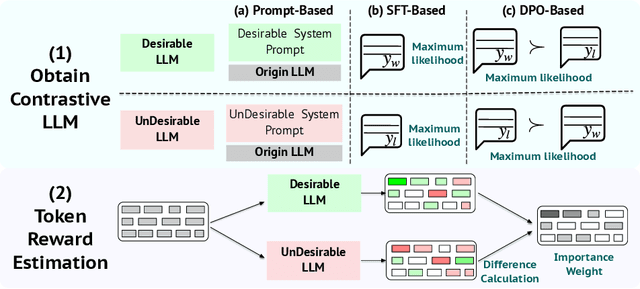
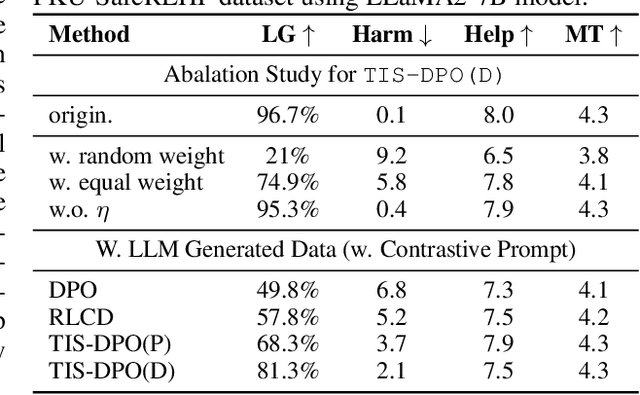
Abstract:Direct Preference Optimization (DPO) has been widely adopted for preference alignment of Large Language Models (LLMs) due to its simplicity and effectiveness. However, DPO is derived as a bandit problem in which the whole response is treated as a single arm, ignoring the importance differences between tokens, which may affect optimization efficiency and make it difficult to achieve optimal results. In this work, we propose that the optimal data for DPO has equal expected rewards for each token in winning and losing responses, as there is no difference in token importance. However, since the optimal dataset is unavailable in practice, we propose using the original dataset for importance sampling to achieve unbiased optimization. Accordingly, we propose a token-level importance sampling DPO objective named TIS-DPO that assigns importance weights to each token based on its reward. Inspired by previous works, we estimate the token importance weights using the difference in prediction probabilities from a pair of contrastive LLMs. We explore three methods to construct these contrastive LLMs: (1) guiding the original LLM with contrastive prompts, (2) training two separate LLMs using winning and losing responses, and (3) performing forward and reverse DPO training with winning and losing responses. Experiments show that TIS-DPO significantly outperforms various baseline methods on harmlessness and helpfulness alignment and summarization tasks. We also visualize the estimated weights, demonstrating their ability to identify key token positions.
Apple Intelligence Foundation Language Models
Jul 29, 2024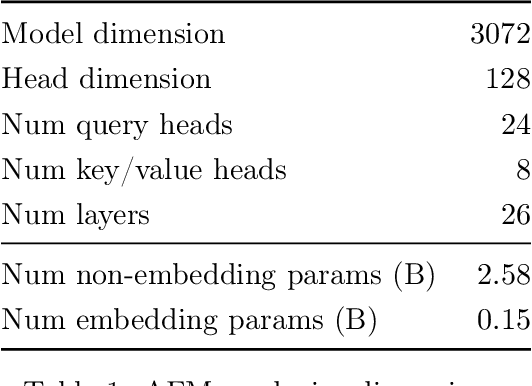
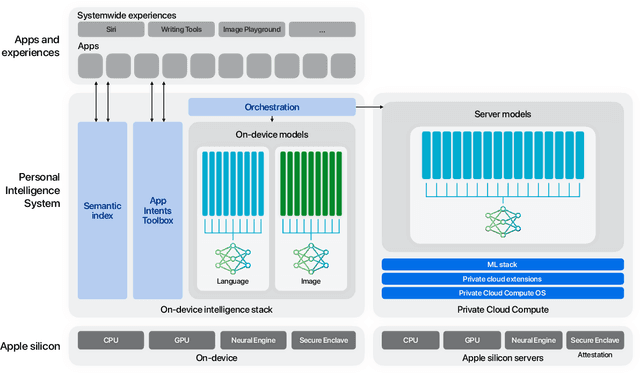

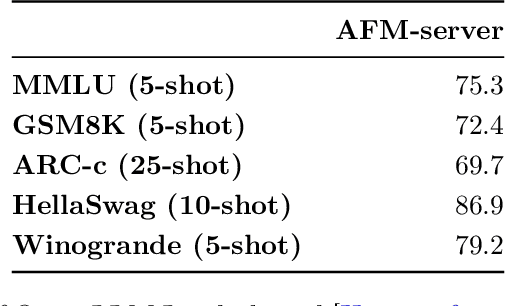
Abstract:We present foundation language models developed to power Apple Intelligence features, including a ~3 billion parameter model designed to run efficiently on devices and a large server-based language model designed for Private Cloud Compute. These models are designed to perform a wide range of tasks efficiently, accurately, and responsibly. This report describes the model architecture, the data used to train the model, the training process, how the models are optimized for inference, and the evaluation results. We highlight our focus on Responsible AI and how the principles are applied throughout the model development.
ODGEN: Domain-specific Object Detection Data Generation with Diffusion Models
May 24, 2024Abstract:Modern diffusion-based image generative models have made significant progress and become promising to enrich training data for the object detection task. However, the generation quality and the controllability for complex scenes containing multi-class objects and dense objects with occlusions remain limited. This paper presents ODGEN, a novel method to generate high-quality images conditioned on bounding boxes, thereby facilitating data synthesis for object detection. Given a domain-specific object detection dataset, we first fine-tune a pre-trained diffusion model on both cropped foreground objects and entire images to fit target distributions. Then we propose to control the diffusion model using synthesized visual prompts with spatial constraints and object-wise textual descriptions. ODGEN exhibits robustness in handling complex scenes and specific domains. Further, we design a dataset synthesis pipeline to evaluate ODGEN on 7 domain-specific benchmarks to demonstrate its effectiveness. Adding training data generated by ODGEN improves up to 25.3% mAP@.50:.95 with object detectors like YOLOv5 and YOLOv7, outperforming prior controllable generative methods. In addition, we design an evaluation protocol based on COCO-2014 to validate ODGEN in general domains and observe an advantage up to 5.6% in mAP@.50:.95 against existing methods.
Direct Large Language Model Alignment Through Self-Rewarding Contrastive Prompt Distillation
Feb 19, 2024Abstract:Aligning large language models (LLMs) with human expectations without human-annotated preference data is an important problem. In this paper, we propose a method to evaluate the response preference by using the output probabilities of response pairs under contrastive prompt pairs, which could achieve better performance on LLaMA2-7B and LLaMA2-13B compared to RLAIF. Based on this, we propose an automatic alignment method, Direct Large Model Alignment (DLMA). First, we use contrastive prompt pairs to automatically generate preference data. Then, we continue to evaluate the generated preference data using contrastive prompt pairs and calculate a self-rewarding score. Finally, we use the DPO algorithm to effectively align LLMs by combining this self-rewarding score. In the experimental stage, our DLMA method could surpass the \texttt{RLHF} method without relying on human-annotated preference data.
From Scarcity to Efficiency: Improving CLIP Training via Visual-enriched Captions
Oct 11, 2023Abstract:Web-crawled datasets are pivotal to the success of pre-training vision-language models, exemplified by CLIP. However, web-crawled AltTexts can be noisy and potentially irrelevant to images, thereby undermining the crucial image-text alignment. Existing methods for rewriting captions using large language models (LLMs) have shown promise on small, curated datasets like CC3M and CC12M. Nevertheless, their efficacy on massive web-captured captions is constrained by the inherent noise and randomness in such data. In this study, we address this limitation by focusing on two key aspects: data quality and data variety. Unlike recent LLM rewriting techniques, we emphasize exploiting visual concepts and their integration into the captions to improve data quality. For data variety, we propose a novel mixed training scheme that optimally leverages AltTexts alongside newly generated Visual-enriched Captions (VeC). We use CLIP as one example and adapt the method for CLIP training on large-scale web-crawled datasets, named VeCLIP. We conduct a comprehensive evaluation of VeCLIP across small, medium, and large scales of raw data. Our results show significant advantages in image-text alignment and overall model performance, underscoring the effectiveness of VeCLIP in improving CLIP training. For example, VeCLIP achieves a remarkable over 20% improvement in COCO and Flickr30k retrieval tasks under the 12M setting. For data efficiency, we also achieve a notable over 3% improvement while using only 14% of the data employed in the vanilla CLIP and 11% in ALIGN.
VISION Datasets: A Benchmark for Vision-based InduStrial InspectiON
Jun 18, 2023Abstract:Despite progress in vision-based inspection algorithms, real-world industrial challenges -- specifically in data availability, quality, and complex production requirements -- often remain under-addressed. We introduce the VISION Datasets, a diverse collection of 14 industrial inspection datasets, uniquely poised to meet these challenges. Unlike previous datasets, VISION brings versatility to defect detection, offering annotation masks across all splits and catering to various detection methodologies. Our datasets also feature instance-segmentation annotation, enabling precise defect identification. With a total of 18k images encompassing 44 defect types, VISION strives to mirror a wide range of real-world production scenarios. By supporting two ongoing challenge competitions on the VISION Datasets, we hope to foster further advancements in vision-based industrial inspection.
Tune-Mode ConvBN Blocks For Efficient Transfer Learning
May 19, 2023Abstract:Convolution-BatchNorm (ConvBN) blocks are integral components in various computer vision tasks and other domains. A ConvBN block can operate in three modes: Train, Eval, and Deploy. While the Train mode is indispensable for training models from scratch, the Eval mode is suitable for transfer learning and model validation, and the Deploy mode is designed for the deployment of models. This paper focuses on the trade-off between stability and efficiency in ConvBN blocks: Deploy mode is efficient but suffers from training instability; Eval mode is widely used in transfer learning but lacks efficiency. To solve the dilemma, we theoretically reveal the reason behind the diminished training stability observed in the Deploy mode. Subsequently, we propose a novel Tune mode to bridge the gap between Eval mode and Deploy mode. The proposed Tune mode is as stable as Eval mode for transfer learning, and its computational efficiency closely matches that of the Deploy mode. Through extensive experiments in both object detection and classification tasks, carried out across various datasets and model architectures, we demonstrate that the proposed Tune mode does not hurt the original performance while significantly reducing GPU memory footprint and training time, thereby contributing an efficient solution to transfer learning with convolutional networks.
RGI: robust GAN-inversion for mask-free image inpainting and unsupervised pixel-wise anomaly detection
Feb 24, 2023



Abstract:Generative adversarial networks (GANs), trained on a large-scale image dataset, can be a good approximator of the natural image manifold. GAN-inversion, using a pre-trained generator as a deep generative prior, is a promising tool for image restoration under corruptions. However, the performance of GAN-inversion can be limited by a lack of robustness to unknown gross corruptions, i.e., the restored image might easily deviate from the ground truth. In this paper, we propose a Robust GAN-inversion (RGI) method with a provable robustness guarantee to achieve image restoration under unknown \textit{gross} corruptions, where a small fraction of pixels are completely corrupted. Under mild assumptions, we show that the restored image and the identified corrupted region mask converge asymptotically to the ground truth. Moreover, we extend RGI to Relaxed-RGI (R-RGI) for generator fine-tuning to mitigate the gap between the GAN learned manifold and the true image manifold while avoiding trivial overfitting to the corrupted input image, which further improves the image restoration and corrupted region mask identification performance. The proposed RGI/R-RGI method unifies two important applications with state-of-the-art (SOTA) performance: (i) mask-free semantic inpainting, where the corruptions are unknown missing regions, the restored background can be used to restore the missing content; (ii) unsupervised pixel-wise anomaly detection, where the corruptions are unknown anomalous regions, the retrieved mask can be used as the anomalous region's segmentation mask.
 Add to Chrome
Add to Chrome Add to Firefox
Add to Firefox Add to Edge
Add to Edge